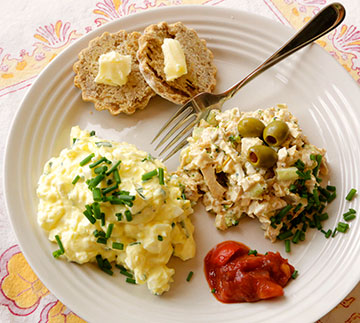We all want to save time and occasionally reach for a box of that or a tin of this to augment our meals. For those of us on a gluten-free diet, it is not as easy, but once you get into the habit of cooking what you like and reading labels, you will have some wholesome foods. But what if you can’t trust a gluten-free claim on the packaged food?
New Study Shows Alarming Results!

“The findings from a study conducted by Moms Across America shed light on concerning levels of glyphosate, pesticides, low mineral content, and even gluten in gluten-free products.”
Celiac.com
“The study tested 46 samples of organic and non-organic gluten-free food products, including bread, pasta, crackers, snacks, flour, dessert mixes, and chips, for glyphosate/AMPA, 236 pesticides, gluten, and mineral content. The results revealed that 44 out of 46 samples tested positive for glyphosate, a known contributor to gluten intolerance. What’s more alarming is that 21% of these samples exceeded the EU threshold for acceptable glyphosate residues.”
You can read the whole article at the link below.
Items listed in the above article on the Celiac.com website in regards to the study: Banza Chickpea Pasta, Simple Mills Brownie Mix, Made Good Foods Soft Baked Double Chocolate Cookies, Simple Mills almond flour crackers, Trader Joe’s Everything Bagel, Simple Mills Brownie Mix, Simple Mills Almond Flour Crackers, Jovial Foods Spaghetti, GoMacro Berry Granola Bar, Shar Pretzels, King Arthur’s Gluten-Free Flour, and Milton’s Sea Salt Crackers.
Whether Gluten-Free or a Traditional Diet, eating less Processed Food Choices is healthier.
These days, more health-minded people are trying to find ways to eat healthier, which involves choosing less processed foods with simpler ingredient labels. It may mean that you will make more things at home, but the long-term benefits of your diet will pay off.
What to look for when reading the labels of processed foods.
- Vitamins and Mineral content can be lessened through processing.
- How processed is the item? How many added ingredients and preservatives are in the packaged food? – For instance, when you buy canned Pumpkin, the healthier tins only have one ingredient: Pumpkin. This is also true of tomato paste; it will say one ingredient: Tomatoes. However, there are others that include more ingredients that may or may not be as healthy.
- Processed foods are often higher in unhealthy additives, such as added sugars, sodium, and less expensive fats, which will be cost-effective for the manufacturer but may not be as healthy.
- Fillers: Processed foods are often engineered to be hyper-palatable, making you crave more and potentially eat more.
You have probably heard the saying, “Your eyes are bigger than your stomach!” Well more accurately, it is probably your brain that has been triggered to like certain processed food tastes. If you have ever eaten a packaged food and it is really hard to stop, chances are it is made with some “filler” designed in the lab to make you want more.
Benefits of Fresh Home-Cooked Meals.
- You have more control over ingredients: You choose what goes in your food, so you can limit unhealthy additives and tailor them to your dietary needs.
- Fresh ingredients tend to be more nutrient-dense, with higher vitamins, minerals, and fiber content. However, growing and soil conditions can affect foods, so knowing where they come from is important.
- Tasty home-cooked meals are often more satisfying and keep you full longer. It is easier to maintain a proper diet with foods prepared at home.

Not all processed foods are bad.
- Minimally processed foods are good choices.
- Sardines, salmon, frozen fish.
- Canned beans and vegetables.
- Frozen vegetables,
- Frozen fruit
- Rice varieties, like brown, red, black, and white
- Gluten-Free Pastas (read the labels)
- Spice Blends
Make Your Own Baked Goods
Buying plain gluten-free unblended flours and other baking ingredients and combining them yourself and baking can be a better choice. It can take longer, but it is doable if you plan, make, and freeze ahead. Have a look at my cookbook, Gluten-Free; You Can Do It, for over 300 delicious recipes.
Eat More, Nutrient Dense Foods that are naturally gluten-free.
People worldwide have eaten various naturally gluten-free foods that are now available in our North American grocery stores. Plantain, Lentils, and Tiger Nuts are just a few of the possibilities. Just remember, as someone who must eat gluten-free for health reasons, label reading must become your superpower.
When you prioritize healthy eating habits by eating a diet rich in whole, unprocessed foods like fruits, vegetables, fermented foods, cheeses, whole grains, nuts, fish, and meats, including organ meats, you will feel fantastic. Fast foods are a fast fix when you are hungry or traveling, but they are not meant to be your steady diet.
Grow Some Food
Whether you have a few small pots on a windowsill filled with basil, cilantro, and parsley or a backyard garden or farm, if you can grow just a few items yourself, you may find the nutritional benefits to be outstanding.
A few summers ago, I started turning a small corner of my tiny backyard into a growing area. I started with some cherry tomatoes, nasturtium flowers, and lettuce. The taste and nutrition were a real add-on bonus to our diet.
In order to avoid chemical fertilizers and add to the soil’s nutrition, I began the practice of vermiculture. So, I ordered about 100 Red Wiggler Composting Worms and started feeding them all my food scraps. Not only do I feel good not to waste; the resulting worm castings are the best fertilizer ever! That is a subject for another blog.
Combining a gluten-free diet with even just a little homegrown produce, or shopping at a farmer’s market, practicing sustainable methods reducing waste through vermicomposting is a fantastic approach to beginning healthier living.
Vitamin and Mineral supplements
It is a fact that soil health is not the same everywhere. If you are living near the ocean, for instance, the foods grown will have a higher concentration of iodine because of the ocean spray. People also tend to be able to eat more seafood containing iodine in these areas. Inland, there can be a deficiency of iodine in the soil, resulting in iodine deficiency that is not entirely filled by eating iodized salt.
It is said that many soils now lack Boron or other trace minerals. You may want to visit your health professional to be tested for a proper vitamin and mineral balance. Always seek professional dietary advice, especially if you are celiac or gluten-sensitive, since your absorption of nutrients could be less than that of others.
Here are a few Recipe Ideas
- Make Vegetable Fritters using grated zucchini, summer squash, and fresh corn off the cob. Use Trina’s gluten-free flour blend recipe for the batter. Top with a dollop of sour cream, plain yogurt, or homemade dipping sauce.
- Grilled Vegetable Skewers: Thread colorful peppers, onions, cherry tomatoes, and eggplant (when in season) onto skewers and grill for a delightful side dish.
- Stuffed Peppers: Hollow out bell peppers or sweet red peppers and fill them with a mixture of ground beef (or pre-cooked brown or black beluga lentils for a vegetarian option), tomato sauce, rice, onions, chopped vegetables, and some chopped basil and oregano. Bake until the peppers are tender.
- Herb Salad with Homemade Vinaigrette: For a burst of flavor, fresh herbs like basil, oregano, and parsley can be tossed into a salad with other garden vegetables. Make a simple vinaigrette with equal parts of olive oil and vinegar. Then, add a dash of lemon juice, salt, and pepper. Shake well and drizzle on top of your salad. If you want to cream it up, add a little yogurt.
Tips for minimizing food waste.
- Plan your meals: Planning meals around what’s in season and what you have on hand can help reduce waste and save preparation and cooking time. Make more than you need and save for another meal.
I make a mean Shepherd’s Pie! It takes some time, but making three or four casseroles is no more work than making one, and freezing saves a lot of time later. - Get creative with leftovers: Repurpose leftover cooked vegetables into frittatas, soups, or stir-fries. Leftover cooked meat can be used in sandwiches, salads, casseroles, soups, or quick stews just by adding some canned beans and a little curry spice.




